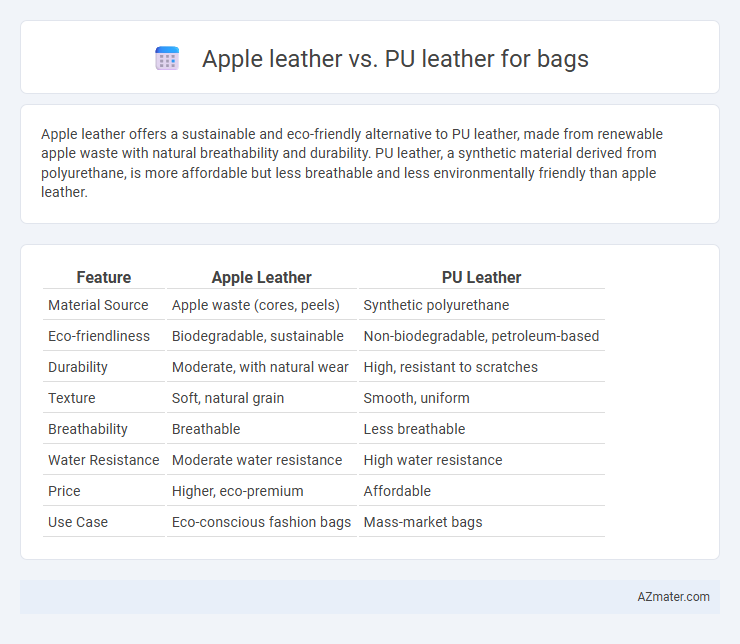Apple leather offers a sustainable and eco-friendly alternative to PU leather, made from renewable apple waste with natural breathability and durability. PU leather, a synthetic material derived from polyurethane, is more affordable but less breathable and less environmentally friendly than apple leather.
Table of Comparison
| Feature | Apple Leather | PU Leather |
|---|---|---|
| Material Source | Apple waste (cores, peels) | Synthetic polyurethane |
| Eco-friendliness | Biodegradable, sustainable | Non-biodegradable, petroleum-based |
| Durability | Moderate, with natural wear | High, resistant to scratches |
| Texture | Soft, natural grain | Smooth, uniform |
| Breathability | Breathable | Less breathable |
| Water Resistance | Moderate water resistance | High water resistance |
| Price | Higher, eco-premium | Affordable |
| Use Case | Eco-conscious fashion bags | Mass-market bags |
Introduction to Apple Leather and PU Leather
Apple leather, derived from sustainable apple waste, offers an eco-friendly alternative to traditional materials with natural breathability and durability. PU leather, or polyurethane leather, is a synthetic material crafted from plastic polymers, known for its water resistance and affordability. Both materials are popular in bag manufacturing, catering to different preferences for sustainability and cost.
Origins and Production Processes
Apple leather, derived from the byproducts of the apple juice and cider industry, uses apple peels and cores that are dried and milled into a powder before being blended with a biodegradable binder to create an eco-friendly material. PU leather, or polyurethane leather, is a synthetic material produced by coating a fabric base with a layer of polyurethane, relying on petroleum-based chemicals and intensive manufacturing processes. The apple leather's sustainable origins reduce reliance on fossil fuels and agricultural waste, contrasting with the petrochemical-intensive production of PU leather.
Environmental Impact Comparison
Apple leather, derived from apple waste, offers a biodegradable and sustainable alternative to traditional PU leather, which is primarily made from non-renewable petroleum-based materials. Its production generates fewer greenhouse gas emissions and reduces reliance on fossil fuels, minimizing overall environmental footprint compared to PU leather. While PU leather contributes to microplastic pollution and slower decomposition, apple leather supports circular economy practices by utilizing agricultural byproducts and promoting eco-friendly manufacturing.
Durability and Longevity
Apple leather, made from natural apple waste fibers, offers greater durability and resistance to cracking compared to PU leather, which is a synthetic material prone to peeling and wear over time. Its eco-friendly composition contributes to enhanced longevity, maintaining structural integrity under regular use and exposure to moisture. PU leather bags often require more frequent replacement due to their lower resilience, making apple leather a superior choice for long-lasting, durable bags.
Aesthetic Appeal and Texture
Apple leather exhibits a rich, natural texture with subtle grain patterns that enhance the bag's aesthetic appeal, offering a unique and eco-friendly alternative to traditional materials. PU leather provides a smooth, uniform surface that mimics genuine leather's sleek look but often lacks the depth and organic feel present in apple leather. The tactile experience of apple leather is softer and more supple, while PU leather tends to be firmer and less breathable, impacting overall comfort and luxury perception.
Comfort and Weight
Apple leather offers a softer and more breathable texture compared to PU leather, enhancing comfort during extended wear. It tends to be lighter due to its plant-based composition, reducing the overall weight of bags and making them easier to carry. PU leather, while durable, often feels stiffer and heavier, which can impact comfort and convenience.
Cost and Market Availability
Apple leather, derived from apple waste, tends to be more expensive than PU leather due to its eco-friendly production process and limited manufacturing scale. PU leather, a synthetic material made from polyurethane, is widely available and cost-effective, dominating the market with affordability and mass production capabilities. The cost disparity influences consumer choices, with PU leather preferred for budget-friendly bags and apple leather gaining popularity in niche sustainable fashion sectors.
Maintenance and Care Requirements
Apple leather bags require gentle cleaning with a damp cloth and occasional conditioning to maintain their natural, biodegradable surface, avoiding harsh chemicals that could degrade the material. PU leather bags are easier to clean with mild soap and water but can suffer from cracking and peeling over time due to their synthetic composition, requiring less frequent but careful maintenance. Both materials benefit from avoiding prolonged exposure to direct sunlight and extreme temperatures to prolong durability and appearance.
Suitability for Different Bag Styles
Apple leather, made from sustainable apple waste, offers a soft texture and durability suited for luxury tote bags and fashion-forward backpacks, enhancing eco-conscious appeal. PU leather provides versatility with its smooth finish and water resistance, ideal for structured handbags, wallets, and everyday carry bags requiring easy maintenance. Both materials cater to diverse bag styles, with apple leather favoring trend-driven, breathable designs and PU leather excelling in classic, resilient pieces.
Final Verdict: Which Is Better for Bags?
Apple leather offers superior sustainability by utilizing fruit waste, making it an eco-friendly choice compared to traditional PU leather, which is petroleum-based and less biodegradable. It provides comparable durability and a luxurious texture while reducing environmental impact, appealing to conscious consumers seeking stylish yet responsible bags. For bags, apple leather is the better option, combining ethical production with quality aesthetics and long-lasting performance.

Infographic: Apple leather vs PU leather for Bag
 azmater.com
azmater.com